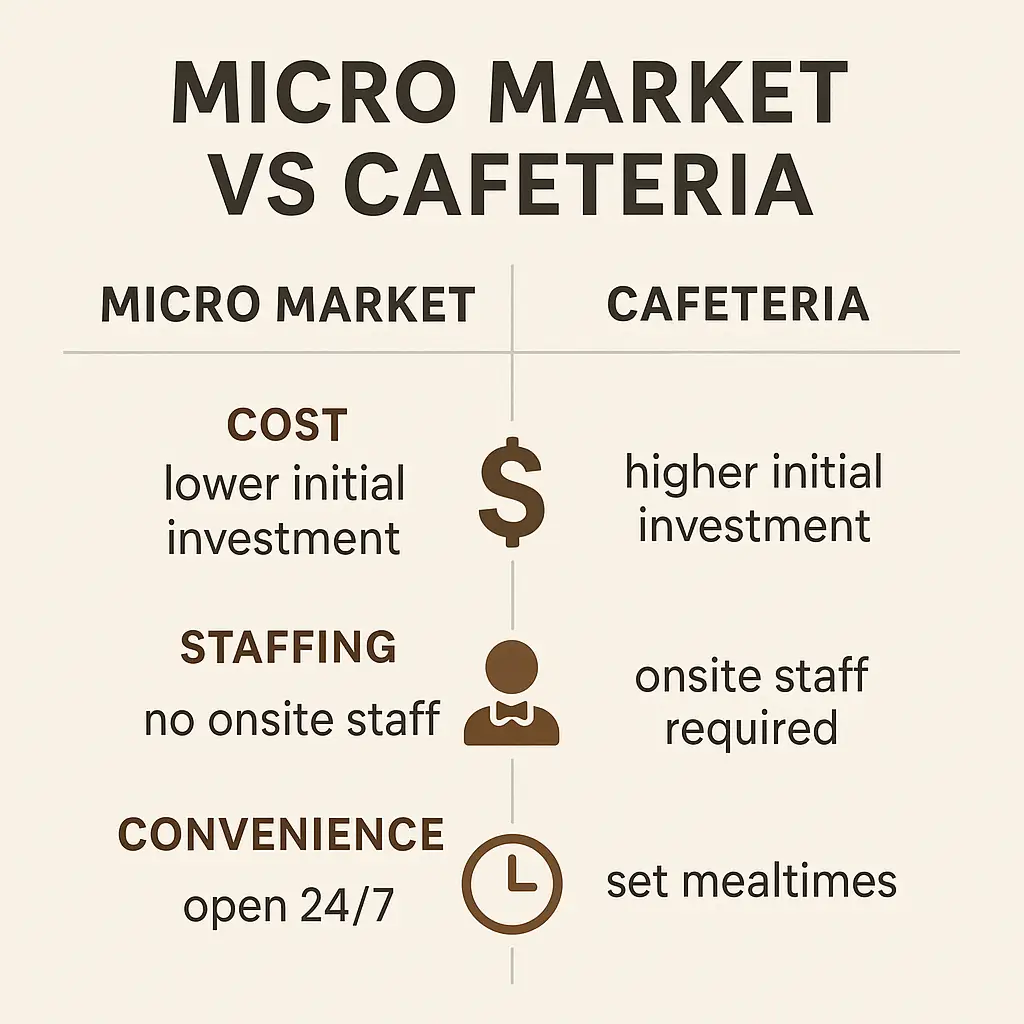Micro Market vs Cafeteria
Explore the differences between micro markets and cafeterias in terms of cost, staffing, and convenience.
Back to Micro Market Services ResourcesExplore the differences between micro markets and cafeterias in terms of cost, staffing, and convenience.
Back to Micro Market Services ResourcesMicro markets typically cost less to implement and operate than staffed cafeterias. They don’t require payroll commitments and utilize smart vending technology with self-checkout systems to keep staffing and overhead minimal.
![]() Micro markets typically require no on-site staff to operate
Micro markets typically require no on-site staff to operate
![]() Cafeterias come with higher equipment and payroll costs
Cafeterias come with higher equipment and payroll costs
![]() Micro markets offer more flexibility with space and layout
Micro markets offer more flexibility with space and layout

Businesses often debate whether a micro market or cafeteria is the better fit for their workplace. Both offer on-site food access, but the logistics, pricing, and maintenance differ greatly. Micro markets are unstaffed food retail spaces with open racks, coolers, and a self-checkout system—perfect for streamlined, touchless convenience. Cafeterias, by contrast, are fully staffed operations with prepared meals and higher infrastructure costs.
The cost difference is often the deciding factor. Setting up a cafeteria includes construction, kitchen appliances, furniture, and hiring kitchen staff. Ongoing payroll and food waste management also add to the budget. Micro markets, however, come fully installed by a qualified vendor at no cost to the location, with regular product restocking and maintenance handled off-site. This makes micro markets ideal for offices, schools, and residential communities that want food options without large capital investments.
Another key difference comes down to staffing and service. Micro markets don't require on-site personnel, minimizing HR overhead and simplifying access outside typical work hours. Cafeterias, however, must maintain a trained staff and manage scheduling, payroll, and benefits—introducing complexity for property or office managers.
From a convenience perspective, micro markets shine in environments that prioritize flexibility and variety without the need for full kitchen services. They feature a rotating selection of snacks, beverages, and healthy shelf-stable meals—all accessible via contactless payment 24/7. Cafeterias may provide hot meals, but are limited by operating hours and staff availability.
Ultimately, micro markets strike a balance between food access, cost-efficiency, and convenience. They scale better for mid-size businesses or multi-tenant properties and require less oversight. If you're deciding between a cafeteria and a micro market, consider staffing needs, installation costs, and how much control you want over daily operations.
For those interested in healthier options, check out our guide to low-calorie vending snacks. To understand costs in other settings, learn how vending services work in hotels.
If you're exploring vending options for your business, Vending Exchange can help simplify the process. Delivery, Installation and Equipment is provided at no cost to you - vendors provide the machines, keep them stocked, and handle all servicing. Whether you need a provider or full-service management, just fill out the form on this page to get started.
No, micro markets operate without on-site staff thanks to smart self-checkout systems and remote vendor support.
Micro markets are typically installed at no cost by vending providers, whereas cafeterias involve construction and equipment purchases.
Micro markets are generally more flexible in layout and can be installed in smaller or underused areas.
Micro markets often include snacks, beverages, healthy meals, and shelf-stable items suited for quick grab-and-go.
Yes, most modern micro markets feature smart terminals that accept credit cards, mobile wallets, and other touchless options.
Micro markets have significantly lower operating costs since they don’t include staff payroll or kitchen maintenance.
Cafeterias may serve well in very large organizations needing hot meals, but come with higher staffing and infrastructure needs.
Yes, products can be rotated regularly to meet customer demand, including healthy and specialty items.
Most micro markets can be installed and stocked in under 7 days by a vending vendor.
Not at all—micro markets are ideal for teams wanting snack and meal access without full kitchen services.